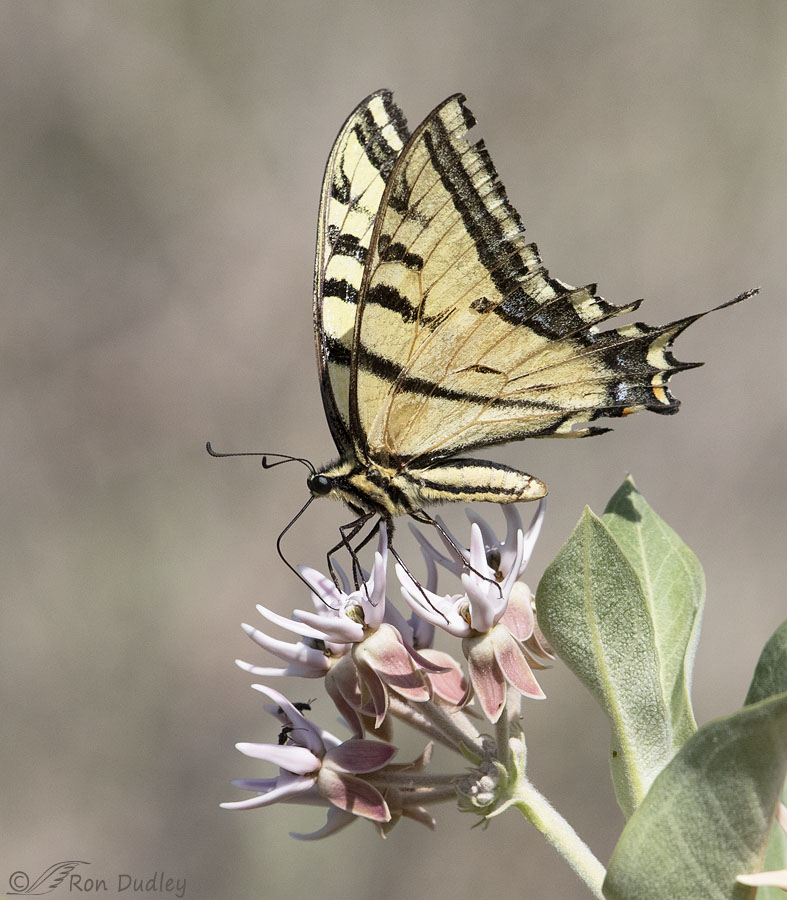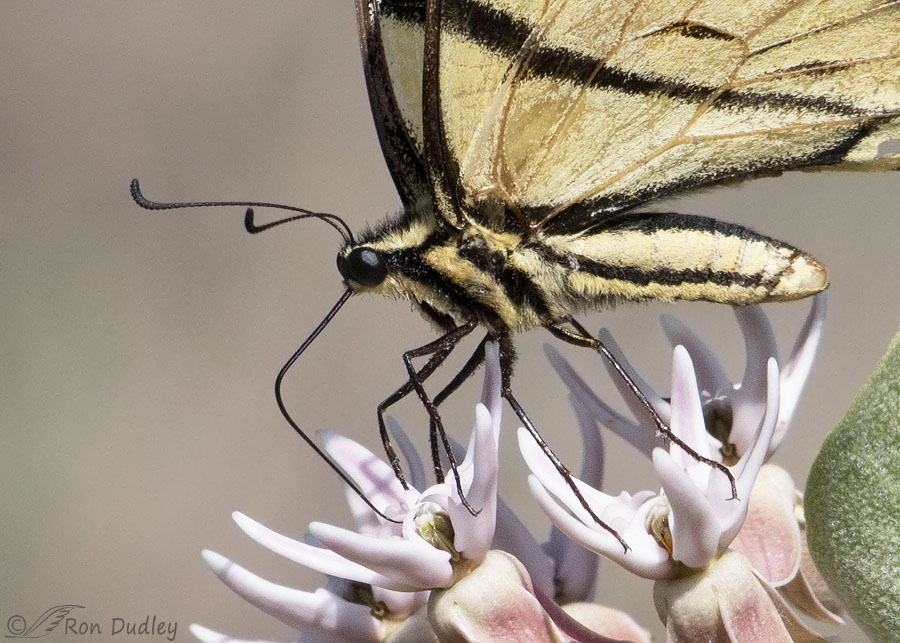Detail. Give me detail.
Macro photography: photography producing photographs of small items larger than life size.
By preference I’m primarily a bird photographer with a ‘minor’ in wildlife photography. But given the means and the opportunity I’ll photograph insects, spiders, flowers, worms, minerals and just about anything else natural. Often that means photographing something small to very small but I’ll be damned if I’ll mount a macro lens to my camera and sacrifice opportunities with birds and wildlife in order to get macro photographs.
And I don’t have to. I can and do use my telephoto lens to shoot macro.

1/3200, f/9, ISO 640, Canon 7D Mark II, Canon EF 500mm f/4L IS II USM + EF 1.4 III Extender
On recent birding trips to the mountains I’ve been watching a clump of Showy Milkweed for the variety of insects it attracts, including bees, ants and butterflies. Two days ago this Two-tailed Swallowtail caught my attention. A beautiful butterfly on an attractive and interesting flower in good light and I had my telephoto lens at hand – how could I resist? Instead of messing around with specialized equipment I just stuck my telephoto lens out my pickup window and fired away.
Technically this is already a macro photograph because the subjects (butterfly, flowers and even the two ants) are larger than life size.

But I had enough pixels for a larger crop and still be able to achieve reasonably good image quality so you know me, I had to do it.
I love seeing detail like this in natural subjects and using my telephoto lens instead of a macro lens allowed me enough depth of field to get almost everything sharp. And if a bird or other critter happened to come along, sometimes in these situations they do, all I’d have to do to take its photo is point my lens in a different direction. Unlike macro lenses, telephoto lenses are incredibly versatile that way. And as a bonus you save the money required to purchase another lens.
Don’t get me wrong. Macro lenses can do things that telephoto lenses cannot. But using telephoto lenses to take macro photographs has its own advantages including:
- More depth of field. Macro lenses are notorious for having extremely shallow depth of field.
- You don’t have to be nearly so close to your subjects so you’re far less likely to scare them away or cause them to change their behavior.
- Because you don’t have to be so close to your subject you’re much less likely to cast a shadow from your camera or your own body onto your subject
And if you have one don’t forget to use your teleconverter when extra magnification would be useful. Contrary to what many folks assume, using a tc does not increase the minimum focusing distance of the lens it’s mounted to.
So if you have the telephoto lens (especially one of high quality) and the desire I’d suggest giving macro photography a try if you haven’t already. It’s fun, it’s challenging and the results are often fascinating.
Ron


I shoot a 70-200 f2.8 as my walk around lens, though not when I am birding. It is so sharp, functioning like a prime throughout it’s focal range, that I use it as a macro a lot. That said, I recently gave away my Tamron 150 f2.8 macro and bought the legendary Nikkor 200mm macro. It is incredible, not just because it’s razor but also because it renders color so brilliantly. But I use it for a very specialized reason, photographing frost fractals, and occasionally insects. Its autofocus is sluggish, so it has its limitations.
“so it has its limitations”
Don’t they all, but some more than others.
Whether you achieve “macro” size through your lens or as a result of cropping, the detail reveals so much. Macro away, I say.
Papilios and Asclepias are always a high point of summer.
And macro away I will, Lyle. Thanks.
Interesting to learn more about equipment. What a gorgeous butterfly. So glad you included the larger crop — now THAT is an action shot!
Thank you, Marty.
Awe, wonder and delight. I had a very ‘ordinary’ night and it is now a little before 3.30. These images are a WONDERFUL distraction from my recalcitrant body and mind.
Thanks, EC. That’s about when I got up this morning. My friends probably think I’m nuts.
That first photo is captivating—love the colors of all the elements, butterfly, shrub, background. And while those big eyes in the cropped image are quite remarkable, I’m really taken by the butterfly’s proboscis, you can almost hear that nectar being sucked up!
Ha, I can hear that slurping in my head right now. Thanks, Chris.
The only time I would use a macro for insects is if I knew in advance that I would be seeing hundreds of insects in one place, such as ladybugs on a log. Even then, my 600mm lens is more versatile, and the result is nearly the same.
Now, while shooting birds, I can quickly divert my lens for a close-up of a fly, bee, butterfly or a frog. Over time, I have built up a nice collection of such “accidental” images. So, way to go, Ron!
Yup, you get it Bob. Thank you.
You make some excellent points regarding this kind of macro photography. I really like this photo Ron, excellent composition. However, I particularly like the colors you captured or perhaps the way you chose to present the colors. They look slightly desaturated, almost pastel, which I personally find very attractive. Have a great weekend Ron and don’t forget that macro lens.
Thank you, Gary. The colors are presented as they showed up in the RAW file. I made no color adjustments. Perhaps the desaturated look comes from the fact that the primary wing visible in the photo is in its own shade.
Stunningly gorgeous photos Ron! And thank you for sharing your lens knowledge. I am quickly lost in the art and language of photography. You are inspiring
Much appreciated, Kathleen.
I photograph small subjects—insects mostly—far more than birds. With that in mind when I bought my first DSLR some years ago—a Nikon D300–I bought a pricey new Nikon macro lens for it and a vintage used and abused Nikon 300mm tele. In the years since I think I have gotten far superior “macro” results from that old tele than from the dedicated macro. The three reasons you cite as advantages are spot on. Were I to do it over I’d buy one high quality tele and use it for both functions. The downside is dealing with the weight and potential awkwardness involved in muscling a long, heavy lens in search of small subjects.
Well said, Jim – all of it.
Ron,
I bought my first DSLR camera (Nikon D80) and lens (Nikon 300mm f/4) in 2007 because I had stumbled upon the website of Ronnie Gaubert, a photographer who lived in Louisiana. You know about him from our interactions on Nature Photography Network years ago. Ronnie’s website had amazing nature, wildlife, and macro images taken with the 300mm f/4 telephoto lens. I bought the lens knowning from Ronnie’s work, that I would need to accept all the blame for my images not looking as good as his. As you know Ronnie died 10 years ago at age 59 after a courageous battle with ALS (Lou Gehrig’s Disease). Many of his photos can still be viewed on photo.net
https://www.photo.net/522962#//Sort-Newest/All-Categories/All-Time/Page-0
Two points about using telephoto lenses for macro photography. Ronnie Gaubert’s macro photos with the 300mm telephoto lens were taken using extension tubes. That changes the minimum focusing distance of the lens and, unlike what you are doing, would require changing your lens setup.
Some Olympus cameras have a shooting mode (Focus Stacking) in which a single shutter activation iinitiates the capture of multiple sequential images, each focused at a different depth plane, which (in one mode) are automatically merged into a single image. I assume that other camera systems have a similar shooting mode. Using a Focus Stacking shooting mode does not require changing lenses. If the goal is to obtain a sharp image of the subject, from front to back, with a soft, out-of-focus background that cannot be obtained with a single shot because of limited depth of field of the telephoto lens, then focus stacking mode can be used.
Dave, I remember Ronnie Gaubert well. I’ve only purchased one print from another photographer and it was his. He was an exceptionally gifted nature photographer.
Interesting post Ron. And the examples you’ve shown certainly speak well for what you are proposing.
The Two-tailed Swallowtail is our Arizona State Butterfly and this time of the year they are very plentiful here. I have taken hundreds of photos of them. Hope you get to see and photograph the very vibrant bright yellow ones. This one is a very faded version of what we see here.
Thanks, Everett. This one was more colorful than it looks. I just chose to post a photo where the primary wing visible to us is in the shade of its own wing.
I’ve tried this myself, with variable results, but it certainly allows for some photos (particularly of insects) that otherwise wouldn’t be possible.At the other end of the lens spectrum, so to speak, I finally figured out that my macro lens can be used at distances I never would have expected. Pushing the limits isn’t always a good idea in life, but with lenses it’s useful.
“Pushing the limits isn’t always a good idea in life, but with lenses it’s useful.”
Very well said, Shoreacres.
Fun! Yes, unless one is REALLY into Macro the telephoto works VERY well. Wonderful photos………
Yes, unless one is REALLY into Macro the telephoto works VERY well. Wonderful photos………
Thank you, Judy.
Beautiful shots. Looks like a Tiger Swallowtail. It’s been around a while as seen by the tattered edges of its upper wings. It’s also a great shot of its proboscis (spelling?) extended and taking up nectar.
Cindy, they’re sort of the western version of the Tiger Swallowtail. And yes, it’s a little beat up.
Nice images. My Canon 300 mm f4/L prime (with 1.4x converter, f/5.6) has a macro switch that lets me get full focus as near as 1.5 meters. It does produce a shallow depth of field but I can close down the aperture a bit to fit more of the habitat into the photo. Bad thing is if I forget to go back to normal setting the camera automatically searches for the nearest object– not good.
Ha, forgetting to change settings for a new situation – a bad habit of mine too!
Smart, smart, smart! And gorgeous shots BTW!
Smart and cheap. Thanks, Pat.